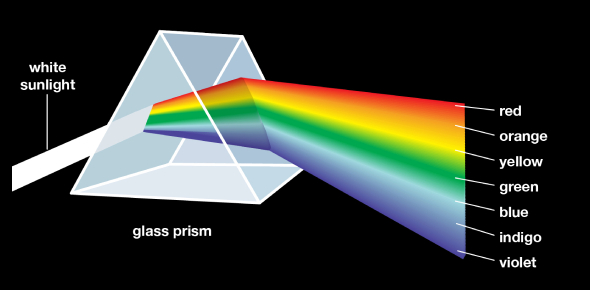Table of Contents
Introduction to Light
Definition of Light
Light is a form of energy that enables us to see our surroundings. It is a type of radiation that our eyes can detect. Light is characterised by its ability to illuminate objects and environments, making them visible to the human eye. It plays a crucial role in visual perception.
How Light Travels?
Straight Line Movement – Experiment with Pipes

- Concept- Light travels in a straight line.
- Experiment- This concept can be illustrated using a simple experiment involving a candle and two pipes—one straight and one bent. When you try to see the flame of a candle through a straight pipe, you can see the flame clearly. However, if you replace the straight pipe with a bent one, you can no longer see the flame. This change occurs because the bent pipe obstructs the straight path of light, demonstrating that light travels in a straight line.
Also Check – What is Light? An Easy-to-Understand Guide
Interaction of Light with Different Materials
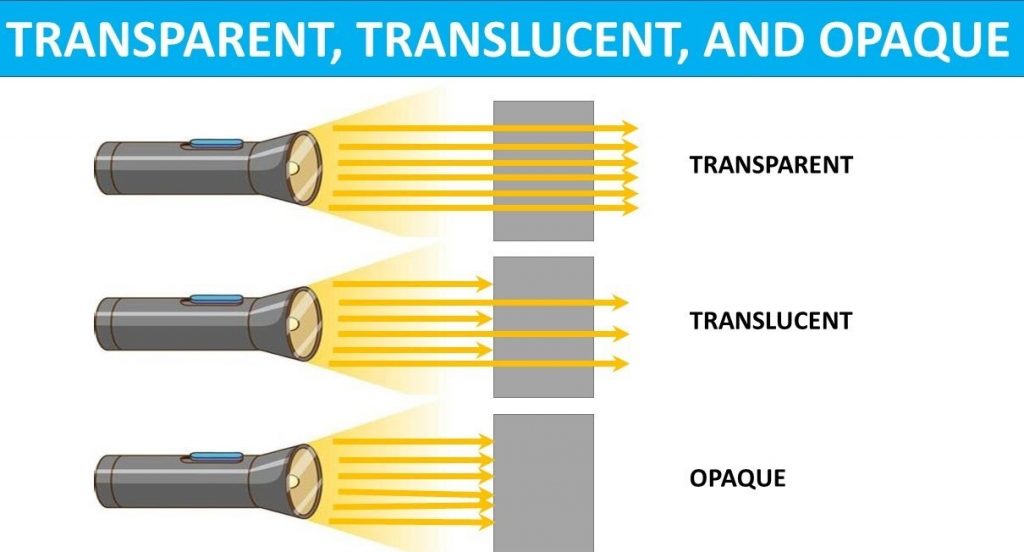
- Transparent Objects- These are materials through which light can pass completely. For example, glass is transparent because it allows almost all light to pass through, making objects on the other side visible.
- Translucent Objects- These materials allow light to pass through them, but not completely. Butter paper is an example of a translucent object, as it lets some light pass through, making objects behind it partially visible.
- Opaque Objects- These are objects through which no light can pass. Typical examples include a table or a book. Since light cannot pass through these objects, they completely block the view of anything behind them.
Also Check – Chapter 11- A Detailed Guide to the Light Activities for Class 7 Students
Basic Principles of Reflection
Reflection of light is a fundamental optical phenomenon where light, upon contacting a surface, is either absorbed or thrown back. This section delves into the basic principles of how reflection occurs and its various aspects.
Definition of Reflection
Reflection of light can be described as the process where light hitting an object is not absorbed but rather thrown back from the surface.Nature of Reflection – When light reflects, it changes its path. This alteration in the path of light is what we observe as reflection.
Also Check – Activity – Reflection of Light from a Plane Mirror
How Reflection Occurs
The occurrence of reflection, a fundamental optical phenomenon, can be explained by understanding how light interacts with different surfaces.

Interaction with Surfaces
- Surface Characteristics- The nature of the surface that light encounters plays a crucial role in determining how reflection occurs.
- Shiny Surfaces- Surfaces that are shiny, like mirrors, act as reflectors. They can be-
- Plane Mirrors- These have a flat surface and reflect light in a manner that the angle of incidence equals the angle of reflection.
- Curved Mirrors- These can either bulge inwards (concave) or outwards (convex), affecting how light is reflected and the nature of the image formed.
Also Check – What is Light Reflection? A Simple Guide to Understanding Reflections
Absorption vs. Reflection
- Dual Behaviour– When light hits an object, it may be absorbed or reflected back. This behaviour depends on the material’s properties and the surface texture.
- Absorption- If the surface is rough or dark-coloured, more light is absorbed, and less is reflected. This absorption can lead to heat generation in some materials.
- Reflection- A highly polished or light-coloured surface reflects more light, leading to the formation of images. The proportion of reflected light dictates the clarity and nature of the image formed.
Transmission of Light
- Transmission in Reflection- Apart from absorption and reflection, transmission is another behaviour exhibited by light when it encounters a surface.
- Through Transparent Materials- In materials like glass or clear plastic, light is transmitted, allowing it to pass through with minimal absorption or reflection.
- Role in Optics- The transmission of light is crucial in optics, as it allows for the creation of lenses, windows, and other devices that rely on allowing light to pass through them.
Formation of Images
Image Formation- One of the most observable effects of reflection is the formation of images.
- When light rays from an object strike a mirror, they are reflected back, and an image is formed.
- This image can either be a real image (formed by the actual convergence of light rays) or a virtual image (formed by the apparent convergence of diverging light rays).
Also Check – NCERT Solutions for Class 7 Science Chapter 15 -Light
Laws of Reflection
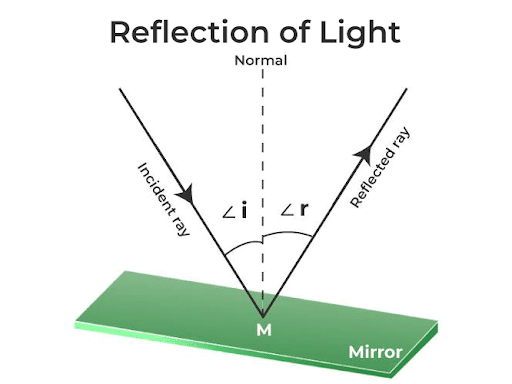
Incident Ray
Definition- The incident ray is the beam of light that approaches and strikes a reflecting surface.
Characteristics-
- It originates from a light source and travels towards the reflecting surface.
- The point where this ray hits the surface is known as the point of incidence.
Reflected Ray
Definition- The reflected ray is the beam of light that bounces off the reflecting surface.
Characteristics-
- After striking the surface, the light ray is reflected away.
- The path of the reflected ray depends on the nature of the surface (smooth, rough) and the angle of incidence.
Normal
Definition- The normal is an imaginary line drawn perpendicular to the reflecting surface at the point of incidence.
Role in Reflection-
- It is a reference line used to measure the angles of incidence and reflection.
- The normal is crucial in determining how light is reflected off a surface.
Angle of Incidence and Reflection
- Angle of Incidence (denoted as ∠i)-
- It is the angle between the incident ray and the normal.
- Measured from the normal to the direction of the incoming ray.
- Angle of Reflection (denoted as ∠r)-
- This is the angle between the reflected ray and the normal.
- Measured from the normal to the direction of the outgoing ray.
- Law of Reflection-
- States that the angle of incidence (∠i) is always equal to the angle of reflection (∠r) (∠i = ∠r).
- This law applies irrespective of the angle at which light hits the surface.
Additional Details
- Same Plane Principle- The incident ray, the reflected ray, and the normal all lie in the same plane. This means they are all in a flat, two-dimensional surface extended in space.
- Surface Texture- The laws of reflection apply to both smooth and rough surfaces, but the quality of the reflected ray differs. Smooth surfaces like mirrors produce clear and well-defined reflections, whereas rough surfaces scatter the light in multiple directions.
What is an Image?
Formation of an Image
- An image is formed when light rays after reflection from a mirror seem to originate from a certain point.
- This point could be either actual or apparent, depending on the type of image formed.
- For instance, when we look at our face in the mirror, the image appears to be situated behind the mirror, where the reflected light rays seem to come from.
Types of Images
Real Image-
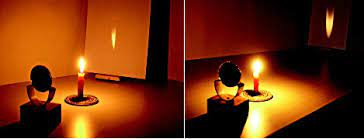
- Formed by the actual convergence of light rays after reflection.
- Can be obtained on a screen, like the image formed on a cinema screen.
- Occurs when light rays coming from an object meet at a point after reflection from the mirror.
Also Check – Activity-Forming Images with a Concave Mirror
Virtual Image-

- Created by the apparent convergence of diverging light rays after reflection.
- Cannot be displayed on a screen, as the light rays do not actually pass through or get received on the screen.
- An example is the image formed by a plane mirror, where light rays appear to meet after reflection.
Plane Mirrors and Image Formation
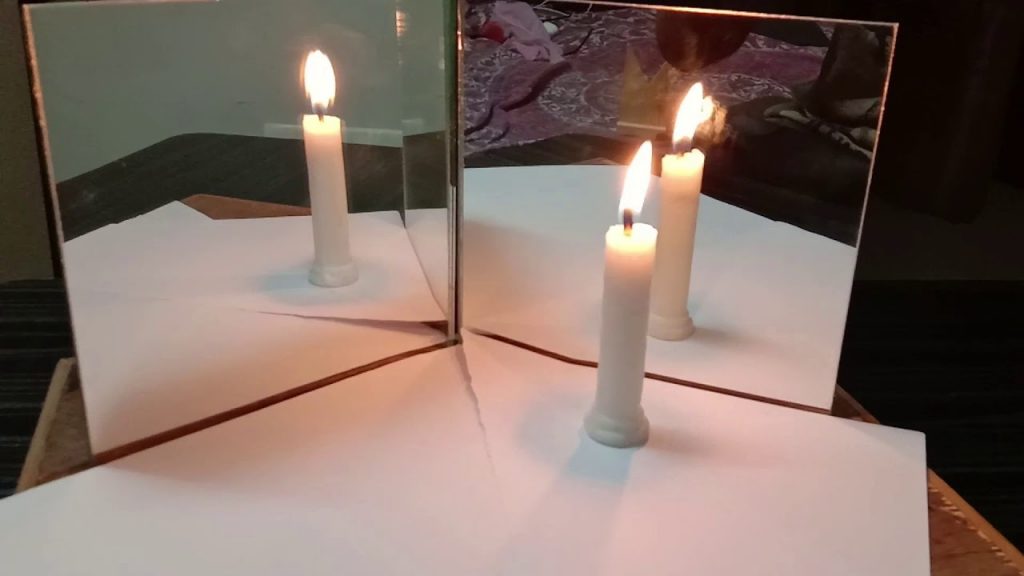
The image formed by a plane mirror has specific characteristics-
- It is always a virtual image, meaning it cannot be projected onto a screen.
- The image appears erect and is of the same size as the object.
- It is located at the same distance behind the mirror as the object is in front of it.
- An observer can only see a reflection in a plane mirror if within its range of visibility. To view one’s entire image, the mirror must be at least half the height of the observer.
Lateral Inversion
Definition
- Lateral inversion is a phenomenon observed in plane mirrors where the right side of an object appears as the left side in its image, and vice versa.
- Recognizing lateral inversion is essential in understanding how images are formed in plane mirrors and why they appear reversed. This knowledge is crucial in areas like design, signage, and even emergency services.
Common Examples and Applications

- Text on Ambulances: A practical application of lateral inversion is seen in how the word “AMBULANCE” is written in reverse. When viewed in a rearview mirror, the inverted text appears correctly, enabling drivers to recognize the emergency vehicle and respond accordingly.
Also Check – Activity- Observing Lateral Inversion in a Plane Mirror
Practical Demonstration with Right or Left Hand Experiment

- The Experiment: A simple experiment can be conducted to understand lateral inversion. When standing in front of a plane mirror:
- Right Hand Lifted: If you lift your right hand, your image in the mirror appears to lift its left hand.
- Left Hand Lifted: Conversely, if you lift your left hand, the image seems to lift its right hand.
- Observation: This experiment shows that while the top and bottom of the candle (or any object) remain the same in the image (erect image), the sides are reversed. This side inversion is a clear demonstration of lateral inversion.
Spherical Mirrors
Spherical mirrors, also known as curved mirrors, are mirrors with the shape of a piece cut out of a spherical surface. They are classified into two types- concave and convex mirrors.
Concave Mirrors
Characteristics of Image
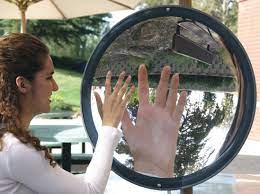
- Concave mirrors can form real, inverted, and magnified images.
- When the object is placed very close to the mirror, the image formed is erect and virtual, instead of real and inverted.
- The nature of the image (real or virtual, erect or inverted, magnified or diminished) depends on the distance of the object from the mirror.
Practical Uses
- Medical Applications- Used by doctors and dentists to get enlarged images of ears, eyes, teeth, etc., for better examination.
- Optical Devices- Employed in devices like telescopes for their ability to magnify distant objects.
- Everyday Objects- Shaving mirrors and satellite dishes use concave mirrors for their reflective properties.
- Automotive and Lighting- Used in headlights of vehicles and torches to focus light into a strong, straight beam.
Convex Mirrors
Characteristics of Image
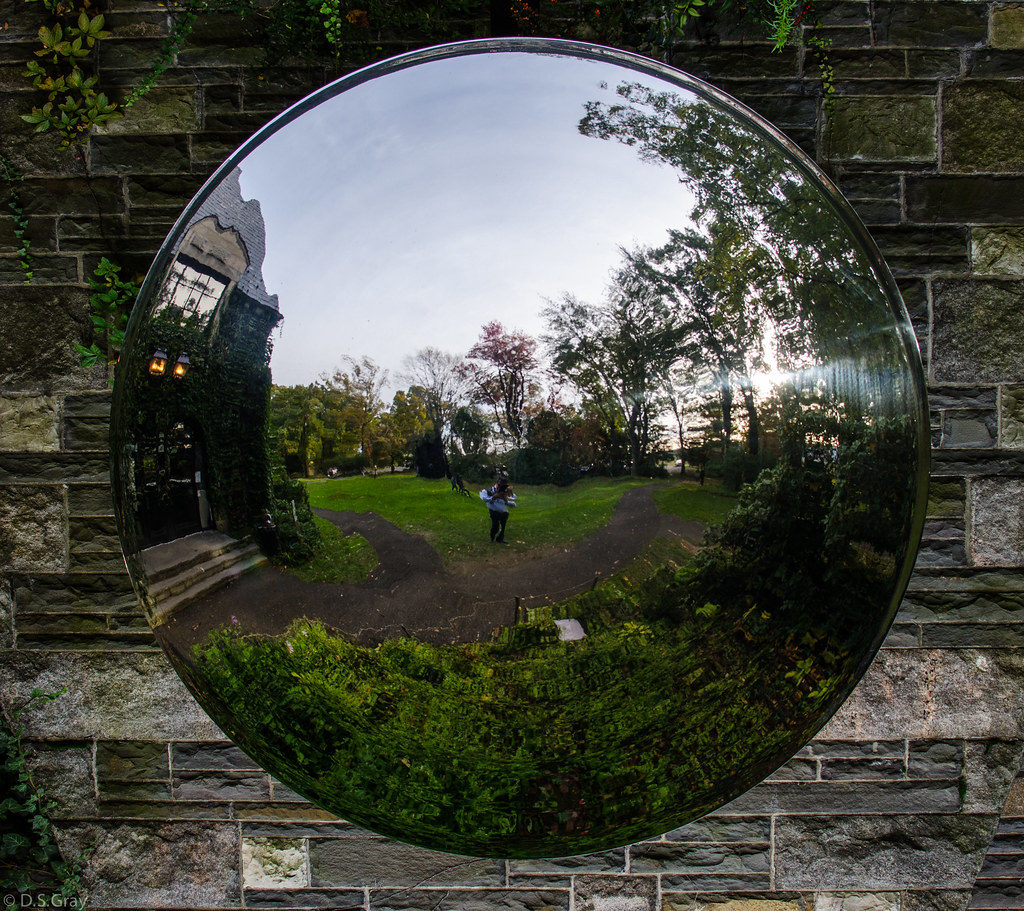
- Convex mirrors form images that are always virtual, erect, and diminished (smaller than the object).
- These characteristics hold true regardless of the distance of the object from the mirror.
- The image appears to be located behind the mirror, and while it’s smaller than the object, it provides a wider field of view.
Practical Uses
- Vehicle Mirrors- Widely used in vehicles as rear view and side view mirrors for their ability to provide a broad view, aiding in driving safety.
- Security and Surveillance- Large convex mirrors are used in shops, road corners, and near ATMs for security purposes, allowing a wider area to be monitored.
- Architectural Design- Employed in architectural designs for creating visual effects and enhancing the perception of space.
Dispersion of Light
Composition of White Light
- Nature of White Light- Although sunlight or white light appears colourless, it is composed of seven different colours. These colours are violet, indigo, blue, green, yellow, orange, and red.
- Observation- This composition becomes evident when white light is passed through certain objects like a triangular prism or when it reflects off surfaces like a compact disc (CD), displaying all seven colours.
Dispersion Through a Prism

Formation of Spectrum
- Discovery by Newton- In 1665, Sir Isaac Newton discovered that white light is a mixture of seven different colours. He demonstrated this by passing a beam of white light through a glass prism.
- Spectrum Formation- When white light passes through a prism, it splits into its constituent colours, forming a band known as a spectrum. The spectrum displays the colours red, orange, yellow, green, blue, indigo, and violet in order.
- Explanation- This splitting occurs because different colours of light bend by different amounts when they pass through the prism. Violet light bends the most, while red light bends the least.
Natural Phenomena – Rainbows

- Formation of Rainbows- Rainbows are a natural manifestation of light dispersion. They occur when sunlight is dispersed by tiny raindrops suspended in the atmosphere.
- Appearance- In a rainbow, the colours appear in an arc with red on the outer part and violet on the inner part, mirroring the order seen in the spectrum.
- Principle- The formation of rainbows involves both refraction (bending of light) and reflection (bouncing of light) within the raindrops, resulting in the colourful arc seen in the sky.
Also Check – Refraction of Light- A Comprehensive Guide for Students
Types of Reflection
Reflection of light can vary based on the surface characteristics of the reflecting object. There are mainly two types of reflection- diffused (or irregular) reflection and regular reflection.
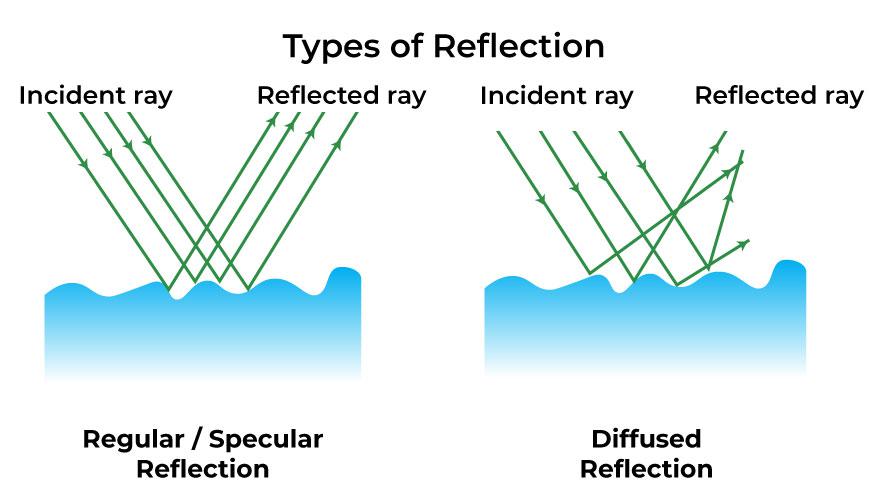
Diffused (Irregular) Reflection
- Occurrence- This type of reflection occurs with irregular or rough surfaces.
- Characteristics-
- Light rays falling on such a surface are reflected back in various directions irregularly.
- There is no uniformity or order in the direction of the reflected rays.
- As a result, the image formed is usually not clear or distinct.
- Examples- Surfaces like walls, wooden objects, or unpolished metals exhibit diffused reflection.
Regular Reflection
- Occurrence- Regular reflection takes place on smooth and shiny surfaces.
- Characteristics-
- Light rays that fall on these surfaces are reflected back uniformly in a specific direction.
- The reflected rays are parallel to each other.
- This leads to the formation of clear and well-defined images.
- Examples- Mirrors, polished metals, and still water surfaces are common examples of surfaces exhibiting regular reflection.
Also Check – Laws of Refraction- A High School Student’s Comprehensive Guide
Differences between Diffused (Irregular) Reflection and Regular Reflection
- Image Formation- In regular reflection, due to the orderly reflection of rays, clear images are formed. In diffused reflection, the scattered rays do not form a clear image.
- Surface Texture- Regular reflection is characteristic of smooth surfaces, whereas diffused reflection is more common with rough, textured surfaces.
- Applications- Regular reflection is utilised in mirrors for clear image formation, while diffused reflection is often experienced in everyday objects and surfaces around us.
Applications of Spherical Mirrors and Lenses in Everyday Life and Technology
Spherical Mirrors in Daily Life
Concave Mirrors
- Satellite Dishes- Used to gather signals and reflect them to a specific point, concave mirrors are essential in satellite dishes for signal reception.
- Medical and Dental Uses- Doctors and dentists use concave mirrors to get enlarged images of ears, eyes, teeth, etc., for better examination and treatment.
- Personal Care- Shaving mirrors often use concave mirrors because they provide an enlarged view, making it easier to see details of the face.
- Automotive and Lighting- Headlights of cars and torches often contain concave mirrors to focus and direct light into a strong, straight beam, enhancing visibility.
Convex Mirrors
- Vehicle Mirrors- Convex mirrors are used in rearview mirrors of vehicles because they provide a wider field of view, which is crucial for driving safety.
- Security and Surveillance- In places like ATMs, convex mirrors are installed to allow users to detect if anyone is watching from behind, enhancing security.
Uses of Lenses in Various Devices
Convex Lenses (Converging Lenses)
Convex lenses are curved outward, thicker in the centre, and narrower at the edges.
Applications
- Magnifying Glasses- Utilised for enlarging the appearance of objects, making them essential in magnifying glasses.
- Optical Instruments- Used in cameras, microscopes, telescopes, and binoculars for their ability to focus light and create clear images of distant or small objects.
Also Check – Convex Lenses- Principles, Applications, and Insights
Concave Lenses (Diverging Lenses)
Concave lenses are curved inwards, with wider edges and a thinner centre.
Applications
- Peepholes- Employed in peepholes of doors, especially in hotels, to provide a wide view of the outside while maintaining privacy.
- Corrective Eyewear- Used in spectacles for correcting certain types of vision problems, like nearsightedness, by diverging light rays before they enter the eye.
Also Check – Difference Between a Convex and Concave Lens
Additional Concepts
Visibility Range in Plane Mirrors
- Definition- The visibility range refers to the area within which an observer can see a reflection in a plane mirror.
- Key Aspect- For a person to see their entire image in a plane mirror, the mirror must be at least half the height of the observer. This is because the image in a plane mirror is always of the same size as the object and appears to be at the same distance behind the mirror as the object is in front of it.
- Implication- This concept is crucial in designing mirrors for various purposes, ensuring that they are appropriately sized for the intended use, like in dressing rooms or bathrooms
Also Check NCERT Exemplar Solutions- Class 7 Science- Chapter 15- Light
Also Check Chapter 15- Light Class 7 science- Very Short Question and Answers
Also Check Chapter 15- Light Class 7 science- Question and Answers
Also Check Chapter 15- Light Class 7 science- Question and Answer (True or False)
Also Check Chapter 15- Light Class 7 science- Question and Answer (Fill in the Blanks)
Also Check NCERT Solutions for Class 7 Science Chapter 15 -Light
Also Check Class 7 Science -Chapter 15- Light- Definition and Explanation of Important Keywords
Also Check Chapter 11- A Detailed Guide to the Light Activities for Class 7 Students
Also Check – Rapid Revision – Class 7 Science -Chapter 15- Light- Complete Notes
